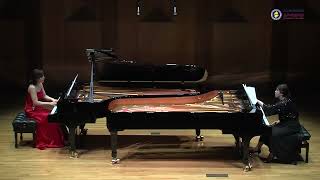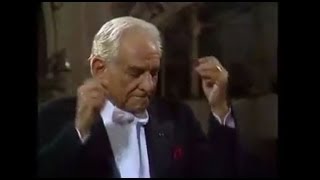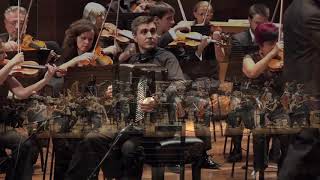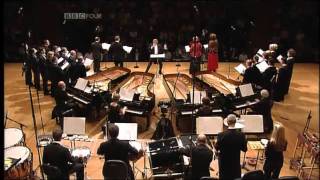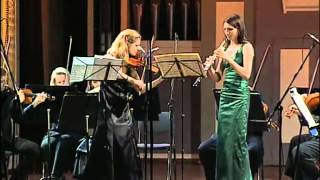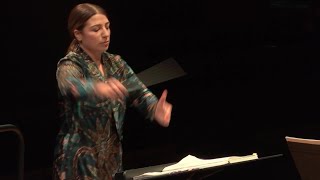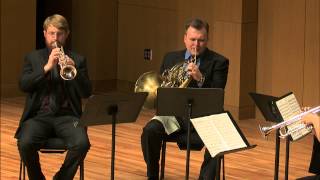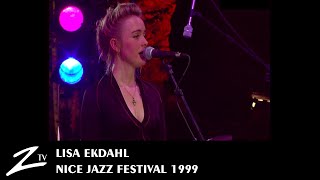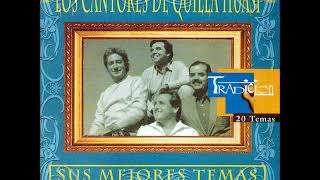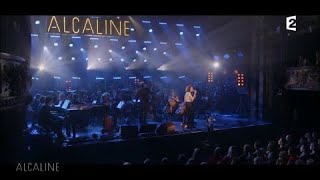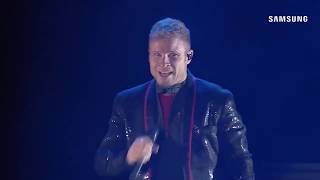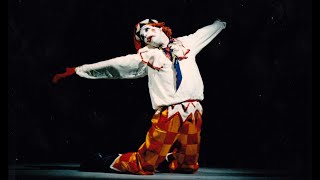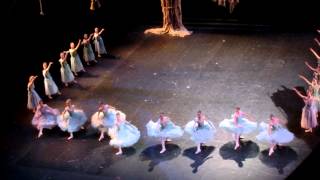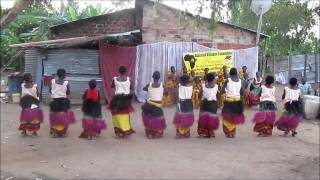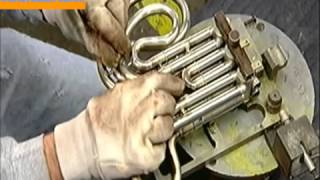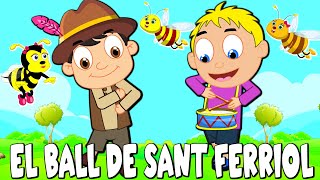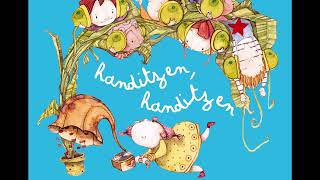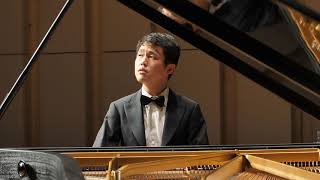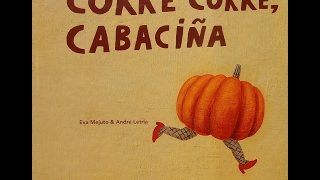June 17 is the anniversary of Stravinsky's birth..
Recommended music videos for initiation to classical music
Igor Stravinsky (1882-1971) was a Russian pianist, conductor, and composer; for many critics, the most important of the 20th century . In his long life he composed a large number of works addressing various styles such as primitivism , neoclassicism , and serialism . Eventually, Stravinsk i's musical future was directed by Sergei Diaghilev , director of the Ballets Russes in Paris , who hired Stravinsky to write a ballet for his company, which would be The Firebird ; Stravinsky left Russia for the first time in 1910, to attend its premiere in Paris by the Ballets Russes . During his stay in that city, he composed two more works for the Ballets Russes : Petrushka (1911) and The Rite of Spring (1913).
The ballets reveal the stylistic development of the composer: from The Firebird , whose style shows the powerful influence of Rimsky-Kórsakov , whose student he was, to Petrushka with its strong bitonal emphasis, to finally arrive at the wild polyphonic dissonance of The Rite . of the spring As Stravinsky mentioned about his premieres, his intention was to "send everything to hell" (and he succeeded: the premiere of The Rite of Spring in 1913 was probably the most famous scandal in music history, with fistfights between members of the public and the need for police surveillance during the second act). For many, these daring and innovative ballets practically reinvented the genre. Later he traveled to the USA in 1939, where he became a naturalized citizen in 1945 and where he continued to live until his death in 1971.
Stravinsky also wrote for various types of ensembles in a wide spectrum of classical forms, from operas and symphonies to small piano pieces and works for jazz ensembles; but not only did he achieve fame as a composer, but this also followed him as a pianist and director, frequently, of his own compositions. He was essentially a cosmopolitan Russian, one of the most influential composers and artists in 20th century music, both in the West and in his homeland; He was also considered by Time magazine as one of the most influential personalities of the 20th century .
Tango is a musical genre and a dance, characteristic of the Río de la Plata region and its area of influence, but mainly of the cities of Buenos Aires (in Argentina) and Montevideo (in Uruguay). Six main musical styles left their mark on tango: the Andalusian tango, the Cuban habanera, the candombe, the milonga, the mazurka , and the European polka . The tango revolutionized popular dance by introducing a sensual dance with an embraced couple that proposes a deep emotional relationship of each person with their own body and of the bodies of the dancers with each other. Musically it usually has a binary form (theme and chorus) or ternary (two parts to which a trio is added). On September 30, 2009, UNESCO declared it Intangible Cultural Heritage of Humanity.
Wolfgang Amadeus Mozart (1756-1791) is considered one of the three giants of musical composition along with Bach and Beethoven . Child prodigy born in Salzburg (Austria), at the age of six he mastered the keyboard and the violin and began to compose. His father, Leopold exhibits him in exhausting tours of different European courts. A prolific composer (more than 600 works written from the age of five until his death), he cultivated all kinds of musical genres: piano works, chamber music, symphonies, concertante works, choral works, operas... each and every one of them, masterpieces of its gender. His operas The Magic Flute, Don Giovanni, Cosí fan Tutte, and The Marriage of Figaro are among the 10 most performed operas in the world. He died in Vienna at the age of 35.
Ave verum corpus is a small musical motet composed by Wolfgang Amadeus Mozart over the short Eucharistic hymn of the same name dating from the 14th century and attributed to Pope Innocent VI . It was composed for the Corpus Christi festival and finished in Salzburg on June 18, 1791 (the year of his death). It was dedicated to Anton Stoll , director of the Baden parish choir, a spa where Constanze , Mozart 's wife, spent long periods of time recovering from her pitiful state of health. The work is composed for choir, strings and organ. This motet is very simple, perhaps because of the prohibition to compose music that was not for the Imperial Court or perhaps thinking about the limitations of the Stoll choir. Either way its value lies in its simplicity and beauty.
Today we offer it conducted by the American teacher Leonard Bernstein (1918 - 1990), composer, pianist and conductor; Bernstein, considered one of the world's greatest conductors, was the first American- born conductor to gain worldwide fame.
Isaac Albéniz (18601-1909) was a famous Catalan composer and pianist, disciple of Felipe Pedrell . Thanks to the help of Guillermo Morphy , Count of Morphy, composer and patron of the arts, he obtained a pension to train at the Brussels Conservatory in 1876, finishing his studies in 1879. Being a virtuoso piano composer, Albéniz also composed music for other instruments and dedicated more than a decade of his almost forty-nine years of life to writing themes for the theater, such as his most successful work Operatic Pepita Jiménez, who also dedicated herself to interpreting concerts or recording her opera Merlin During her career she wrote more than two dozen songs, as well as several orchestral and chamber numbers.
Asturias was composed in the 1890s, a time when Albéniz was residing in London . Despite its name, the theme has no relation to the musical tradition of Asturias , being rather related to Andalusian flamenco. Upon its publication, Albéniz conceived it as a prelude to the Chants d'Espagne collection. Years later it would become the fifth movement of the Suite española , published after Albéniz 's death under the current title and subtitled Leyenda in 1911 by the German publisher Hofmeister .
The version that we offer today is arranged for accordion and symphony orchestra with the world-renowned accordionist from Gipuzkoa, Iñaki Alberdi as a soloist accompanied by the Castilla y León Symphony Orchestra conducted by maestro José Luis López Antón .
Andrew Lloyd Webber (1948) is a late 20th century composer, writer, author, producer, director and director of numerous plays. He has produced 16 musicals, two soundtracks and a Requiem mass in Latin. His awards include three Tonys , three Grammys , an Oscar , an Emmy , seven Oliviers , and a Golden Globe . His company, the Really Useful Group , is one of the largest in London . Some of the songs from his theater plays, such as Don't Cry For Me, Argentina (from Evita ) and Pie Jesu (from his Requiem Mass ) have been successful in Europe and America outside of theater performances and have been sung by many artists. Some of his musicals like Jesus Christ Superstar, Evita, The Phantom of the Opera and Cats have been brought to the big screen with great success.
Evita is a rock opera with music by Andrew Lloyd Webber and lyrics by Tim Rice , loosely based on the life of Eva Duarte (“Eva Perón”), an Argentine political leader and second wife of President Juan Domingo Perón . The play offers a critical look at the character of Eva , from her humble origins to her rise to power and untimely death at the age of thirty-three. "Don't Cry for Me Argentina" ("Don't cry for me Argentina") is a song from the musical Evita . The theme represents the emotional speech of María Eva Duarte on the balcony of the Casa Rosada, in front of the shirtless masses, after Perón won the presidential elections of 1946 and she became the first lady of Argentina . Today it is offered to us by the singer and actress Nicole Scherzinger (Honolulu, Hawaii, 1978).
Recommended classical music videos
The Cantata is a musical piece written to be “sung”, by one or more solo voices with instrumental accompaniment, generally articulated by several movements and sometimes, with a choir. The oldest type of cantata , known as cantata da camera , was born towards the end of the 17th century, composed for solo voice on a profane text, while the religious cantata was created for religious rites. These cantatas were generally articulated with an initial chorus in which the sopranos began the musical theme, completed by a succession of arias , recitatives , and chorales , sometimes with passages by solo instruments that played the melody prepared for the voice. The fundamental difference with the oratorio is that it has an argument that supports it.
The Weddings (French, Les noces ; Russian, Свадебка, Svádebka ) is a danced cantata or ballet with soloists to music by Igor Stravinsky . As a ballet it premiered on June 13, 1923 at the Théâtre de la Gaîté in Paris , by the Ballets Russes . Stravinsky first conceived of writing this cantata in 1913 and finished it in an abridged score by October 1917. During the long gestation period, the orchestration changed drastically; Initially conceived for an enlarged symphony orchestra, due to various incidents, it ended up establishing the following complement: soprano, mezzo-soprano, tenor, and bass soloists, a mixed choir, and two groups of percussion instruments, including four pianos. Today's version is conducted by the eminent Russian teacher Valeri Guérguiev (1953).
Johann Sebastian Bach (1685-1750) was a German violinist, organist, conductor, and composer, born in Eisenach into the most prominent musical family in history. In 1703 he got his first job in Arndstat and in 1707 he moved to Mülhausen as an organist, where he married his cousin Maria Barbara with whom he had seven children. After the death of his wife in 1720, he remarried Maria Magdalena with whom he would have another thirteen children. In 1723 he moved to Leipzig where he would reside until his death at the age of 65. Considered one of the three main geniuses in the History of Music along with Mozart and Beethoven, his influence has been notable on Haydn , Mozart , Beethoven , Mendelssohn , Schumann , Chopin ... and many other renowned composers.
The Concerto is a musical form written for one or more solo instruments accompanied by an instrumental ensemble. It was Vivaldi who established the fundamental bases of its structure with three movements ( I fast-II slow-III fast ) and presented as a dialogue between the soloists and the instrumental ensemble. Beginning with classicism (1750-1810), especially from the bases created by CPE Bach , the first movement is built following the patterns of the sonata form (exposition, development and re-exposition) , while the second and third movements adopt free and punctual forms. Frequently, at the end of the first and/or third movement, the soloists have a cadence without orchestral accompaniment with which they can show off their virtuosity.
The Concerto for Oboe and Violin BWV 1060 is written for solo violin, solo oboe, strings and continuo and structured in three movements without cadenzas: I (0´12´´) ALLEGRO .-. II (5´09´´) ADAGIO .-. III (10´05´´) ALLEGRO. Today it is offered to us by Agne Doveikaite-Rubine (violin) and Juste Gelgotaite (oboe), accompanied by the Kremerata Baltica Chamber Orchestra .
Paul Dukas (1865-1935) was a French composer. In 1881, he entered the Paris Conservatoire in Théodore Dubois 's harmony class. In 1884 he heard the orchestra for the first time in its Ouverture pour Götz von Berlichingen . The following year he was admitted as a composition student of Ernest Guiraud and in 1886 he won first prize for counterpoint and fugue. In 1888 he won the second Prix de Rome for his Cantata Velléda , but the following year he was denied the first Grand Prix ; He then left the Conservatoire and devoted himself seriously to his work and to the study of César Franck and Richard Wagner on the one hand, and the symphonic impressionism of Claude Debussy on the other. Skilled orchestrator, one of his most important works is The Sorcerer's Apprentice.
L'Aprenti sorcier (The Sorcerer's Apprentice), which we present today under the baton of the Finnish teacher Dalia Stasevska , is a symphonic poem composed in 1897 by Paul Dukas based on the ballad of the same name Der Zauberlehrling (in German) by Johann Wolfgang von Goethe . It is an orchestral work that belongs to the program music style and represents the story of an apprentice who, without permission, enchants a broom to help him carry water. The popularity of the piece grew with the Walt Disney film Fantasia (1940).
Malcolm Henry Arnold (1921-2006) was a British composer, one of the most important of the second half of the 20th century . He began his career as a professional trumpeter, but around the age of thirty he decided to dedicate himself exclusively to composition. He composed more than five hundred works, both classical music and documentary and film (obtaining, in 1957, an Oscar for best soundtrack for The Bridge on the River Kwai ). He was one of the most controversial English composers of the 20th century , due to a neo-romantic and neoclassical style that had already been practically relegated to the past and his consequent friction with specialized critics. Despite everything, he was awarded the title of Commander of the Order of the British Empire .
A Brass Quintet is a chamber music ensemble made up of five brass instruments; The most common formation, as in the video that we are showing today, is that of two trumpets, a French horn, a trombone and a tuba. By extension, metal quintet also means a composition performed with this type of grouping. It appears in the 20th century , more specifically in the 1940s in the United States , and could be said to be the brass wind equivalent of the string quintet .
Today we offer Malcolm Arnold 's Brass Quintet No. 1 , structured in three movements: I (0´02´´) ALLEGRO VIVACE .-. II (4´57´´) CHACONNE (ANDANTE WITH MOTORCYCLE) III (10´11´´) WITH BRIO. Performance is by the UNT Center Brass Quintet.
Recommended music videos for all tastes
Lisa Ekdahl (Stockholm, 1971) is a Swedish singer, who preferably uses English in her jazz works and Swedish in others. It is characterized by a high-pitched and very soft voice. In the 1990s he became one of the leading figures in Swedish pop . In 1994, her self-titled debut album came out in Sweden and her single "Vem Vet" made her a superstar in Scandinavia at the age of 23. The singer's first English-language effort was 1998's When Did You Leave Heaven , which was also her first jazz record and the first album to come out in the US , becoming a critical and best-selling success in Sweden and throughout Europe . The following year, she published her second album in English, Back on Earth , which has since established her as one of the great contemporary jazz singers.
Los Cantores de Quilla Huasi is an Argentine folk group created in Buenos Aires in 1953. It is considered one of the most important groups in the history of Argentine folk music. They published 38 official albums popularizing Argentine folk styles such as the zamba , the cueca , the chacarera , the gato or the chamamé . They made their debut at the traditional Richmond Confectionery in Buenos Aires and recorded their first album in 1956, with the TK recorder. In 1964 they made their debut at the Cosquín Festival and the following year, on the night of Monday, January 24, they were singing from 2 to 6 in the morning, ending up being carried on a litter by the crowd. Over the years, the formation has been maintained despite the various replacements until Carlos Lastra, founder of the group, died in 2012.
Jane Birkin (London 1946) is an Anglo-French actress and singer who has lived in France since the late sixties. After his film beginnings in the UK , notably in the film A Midsummer Morning Wish , he began a career in France , where he met his later mentor, composer and partner, Serge Gainsbourg . Her weak voice became her trademark and was used wisely. One of their first collaborations was the song Je t'aime... moi non plus , which became an international hit. In the late 1980s, she performed in a series of concerts in Paris performing the repertoire that Gainsbourg had written for her. In 2017 he published his thirteenth studio album, "Birkin-Gainsbourg le symphonique" .
The Backstreet Boys is an American pop music boy band founded in Orlando , Florida on April 20, 1993. The band consists of AJ McLean, Howie Dorough, Brian Littrell, Nick Carter and Kevin Richardson. They rose to fame with their debut album, Backstreet Boys (1996), while their subsequent albums continued the group's worldwide success. The band has sold more than 110 million production records, making them the best-selling boy band of all time and one of the world's best-selling music artists. They are the first group since Led Zeppelin to have their first ten albums reach the top 10 on the Billboard 200 , and they become the only boy band to do so. The group received a star on the Hollywood Walk of Fame on April 22, 2013. The group also released their first documentary film, titled Backstreet Boys: Show 'Em What You're Made Of in 2015.
Recommended peculiar videos
Petrushka , is a ballet in one act and four scenes with choreography by Michel Fokine , music by Igor Stravinsky , libretto by Stravinsky himself and Alexandre Benois , and sets and costumes also by Alexandre Benois . It was composed during the winter of 1910-11 and premiered in Paris , at the Châtelet Theater by Sergei Diaghilev 's Ballets Russes , on June 13, 1911 and under the musical direction of Pierre Monteux . Petrushka is a puppet made of straw and sawdust with a buffo and mocking character, who comes to life and develops the ability to feel. The work is characterized among other things by the so-called Petrushka chord , consisting of a chord of C major and F sharp major played simultaneously ( polytonality ), which usually accompanies the appearance of the Petrushka character almost as a leitmotif.
Scene I (0´34´´)
In 1838, in the Admiralty Square of Saint Petersburg, the carnival fair, the Maslenitsa, is held. In the square there is a small theater where the Magician presents a show. When the curtain opens, three dolls are seen that, at the Magician's command, begin to dance. The Moor and Petrushka are in love with the Dancer, but the latter clearly prefers the Moor. Petrushka in a jealous rage attacks the Moor and the Magician stops the presentation.
Scene II (10´34´´)
Locked in his room by the Wizard, Petrushka protests the cruelty with which he is treated for showing his feelings. The Ballerina appears and Petrushka, excited, expresses his love for her brusquely. The Ballerina leaves, frightened by Petrushka's rudeness, leaving him in sadness and despair.
Scene III (15'05'')
In the Moor's room. Although El Moro is also a prisoner, he is happy with his situation. The Dancer enters and the Moor flatters her, she is pleased with the deal and allows herself to be embraced by him. At that moment Petrushka enters who threatens El Moro, he defends himself with his scimitar and makes Petrushka flee.
Scene IV (21'43'')
The carnival fair on the square in St. Petersburg. People have continued with the celebrations without realizing what is happening inside the theater. The party is interrupted when Petrushka leaves the theater followed by El Moro. The Moor kills Petrushka. People are scared thinking that a murder has been committed, the police arrive and question the Wizard, but on the floor there is only a rag doll. The party comes to an end, everyone leaves and the Magician takes Petrushka to the theater but Petrushka's ghost appears threateningly from the ceiling.
La Source is a ballet in three acts with a score done collaboratively by Léo Delibes and Ludwig Minkus . La Source was Delibes 's first ballet composition, although when it was premiered in 1866, it did not acquire much popularity. The ballet boasts a very oriental-style score, a common choice in its time.
Léo Delibes (1836 -1891) was a French romantic composer. His mother was a musician and his grandfather an opera singer. His nephew Frédéric was the paternal grandfather of the Spanish writer Miguel Delibes . He began his musical studies at the Paris Conservatoire in 1847, where he was a student of Adolphe Adam . As a composer, he achieved real fame in 1870 with the success of his ballet Coppélia; Among his other ballets, Sylvia , written jointly with Léon Minkus ; the Pizzicato of this ballet is very popular, one of Delibes ' greatest successes. He also composed several operas and operettas, a mass, a cantata, and occasional music for the theater, such as dances and ancient airs.
Ludwig Minkus (1826-1917) was an Austrian violinist and composer of ballet music. He studied at the Vienna Conservatory . At that time, at the same time that he composed music for ballet, he acted as a violin soloist and founded an orchestra that would compete with that of the young Johann Strauss . In 1846, Minkus moved to Paris and that same year the ballet Paquita premiered, with music by Édouard Deldevez helped by Minkus . In 1847 he settled in Russia ; in 1861, he joined the Bolshoi Theater Orchestra as a violinist; a year later, as director and two years later he is appointed composer of the Bolshoi Ballet . Although permanently settled in Russia , he maintained his ties with Paris and in 1866 he traveled to the French capital to compose the new ballet La Source .
Ugandan dance . One of the best traditional African dances performed by young people we have ever seen. The Sanyu Boys' Choir rehearses one of the most popular dances of the Baganda tribe in their village of Katooke in Mubende District - Uganda. This was a great after school program for these kids, but due to lack of funding after supporting them for a couple of years, we had to close this program. It was very painful for everyone and we hope that one day God will provide the means to support this program in the future. (Extracted from the comment at the bottom of the video).
The French horn or French horn is a metal wind instrument that has a very versatile character and covers a very wide range. In addition, this instrument can emit both soft and sweet sounds as well as rough and hard ones. There are certain technical resources that allow the horn to achieve special timbre effects: mute, bouché, damper and cuivré . Its ancestor is the hunting horn . The trunk is formed by a narrow and long tube. This conical metal tube is rolled up and ends in an open pavilion or bell (in the shape of a trunk) and begins at the so-called tudel (the beginning of the body of the instrument) in which the mouthpiece is placed. The sound is produced by the vibration of the lips inside the mouthpiece, due to the action of air pressure: it is refined until it reaches the pavilion, where it is emitted to the outside.
Recommended music videos for children
Various Wikipedia articles have been used to write these texts.
The texts of Videomusicalis are written in Basque, Spanish and English.





